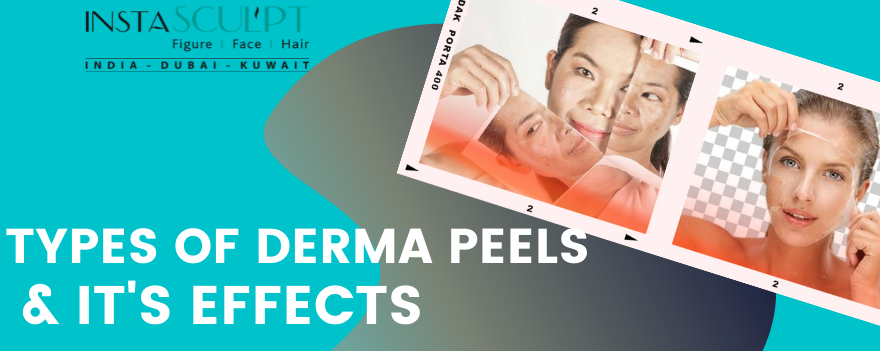Peels are a technique used for improving the texture of the skin, to get rid of the blotchy, sun-damaged skin, and get a youthful glow, derma peels are helpful. It is a non-surgical and non-invasive process where exfoliation of the dead skin takes place from the outermost layer of the skin resulting in peeling off those layers. This process gives a uniform color to the skin and reduces spots and blemishes. It works effectively on the skin by removing the impurities and leaving smoother, radiant, and softer skin.
Peels exfoliate the dead cell in the skin and a layer of skin is peeled off. As dust and pollution settle on the skin, a layer of dead skin is developed. In a peel, the skin gets cleansed and uniformly medicated throughout the skin layers depending upon the type of peels used, unlike scrubbing where the cleansing occurs only on the superficial level.
One may experience dryness or erythema of the skin for a couple of days and sometimes peeling of the skin may also take place. But, following this process, one can experience brighter and radiant-looking skin. Peels are available for various issues based on the condition of the skin. After a skin analysis, the type of skin is identified, and based on this the peels are selected. Nowadays most of these peels are gel-based hence hardly have any side effects.
The most common skin issues which can be taken care of by derma peels are acne, pigmentation, dark circles, wrinkles, tanning, uneven skin tone, and texture. The procedure takes around 20 to 30 minutes based on the skin sensitivity; a proper cycle for the procedure ranges from 8 to 12 days.
Some of the types of peels (based on the depth of peel) are mentioned below:
a. Superficial peel acts on the top layer of the skin known as stratum corneum and has no effect beyond it. It gives an instantly brighter or smoother texture. Some of the superficial peels may have acted on the next layer below the skin known as the epidermis.
b. Medium depth peels: Penetrate deeper into the skin up to an upper layer of the dermis as these are Trichloroacetic acid (TCA) derived peels. For a deep peel, the strongest type of chemical peel for deeper lines and wrinkles and stubborn pigmentation is used. It contains high-strength TCA for deeper penetration into the dermal layers of the skin.
c. Deep peels: Has action on the entire dermis.
The superficial peel is done at the skin level whereas the medium and deep peel goes up to the epidermis and dermis levels as well. The deep peel especially penetrates deeper into the skin and has an impact on the collagen and keratin as well. A superficial peel is done to reduce acne, photoaging, hyperpigmentation, rejuvenation (Radiant looking skin) however, for those who require tightening of the skin and heal wrinkles along with the other problems medium or deep peels can be preferred.
Usually, the skin is cleansed and the chemical is applied based on the skin type. The length of time before the peel can be neutralized and then removed is generally smaller for a medium or deep peel. If the time period exceeds the appropriate time required skin may end up with scarring or aggravation of existing pigmentation meantime which eventually wears off. This helps to accomplish a more extensive modification to the skin, and the process is usually monitored by a physician or another medical staff is present to administer the procedure safely and effectively.
A Superficial peel is conducted only on the face whereas a deep peel can be done on other parts of the body as well. Deep peels are light-sensitive and hence it requires special containers whereas a superficial peel can be stored in a tightly capped bottle. Deep peel has more penetrating or deeper effects compared to the others. Superficial peels up to 70% can be used without side effects but it’s risky to use deep peels more than 20%.
There happen to be few side effects of Derma peel, especially for those with sensitive skin. Some may encounter a burning sensation or irritation during the recovery period. The skin seems flaky and gradually peels off lightly after every session. For those with extremely dry skin, it may seem very uncomfortable t0 step out after a deep or medium peel due to the peeling of the skin.

